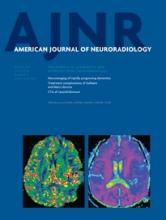Abstract
BACKGROUND AND PURPOSE: Time-resolved MRA with the use of bolus injection of paramagnetic agents has proved valuable in neurovascular imaging. Standard contrast agents have limited blood-pool residence times, motivating the development of highly protein-bound blood-pool agents with greater relaxivity and longer intravascular residence, affording improved image quality at lesser doses. This study represents the first comparison of blood-pool agents to standard agents in time-resolved cerebral MRA.
MATERIALS AND METHODS: One hundred datasets were acquired at 1.5T by use of a standardized, time-resolved MRA protocol. Patients received either unit dosing of a standard extracellular agent at 0.1 mmol/kg or a blood-pool agent at 0.03 mmol/kg. Peak arterial and venous enhancement phases were identified and subsequently scored qualitatively by use of a 4-point Likert scale, with attention to 6 vascular segments: 1) intracranial ICA; 2) MCA M1; 3) MCA M2; 4) MCA M3; 5) deep cerebral veins; and 6) dural venous sinuses.
RESULTS: Fifty MR angiographies were acquired with each agent. No significant differences were found between agents in generation of uncontaminated arteriograms. Blood-pool agents, at 67% dose reduction, were of significantly greater quality across most vascular segments, including ICA (P = .019), M2 (P = .003), and M3 (P < .01). Superiority in the M1 segment approached significance (P = .059). Significantly better venographic quality was noted for deep venous structures (P = .016) with the use of blood-pool agents.
CONCLUSIONS: Blood-pool agents provide superior demonstration of most intracranial vessels in time-resolved MRA compared with standard agents, at reduced doses. The greater relaxation enhancement and more favorable dosing profile make blood-pool agents superior to standard agents for use in cerebral time-resolved MRA.
ABBREVIATIONS:
- TR-MRA
- time-resolved MRA
- BPA
- blood-pool agents
- SCA
- standard contrast agents
- DAVF
- dural arteriovenous malformation
- © 2014 by American Journal of Neuroradiology
Indicates open access to non-subscribers at www.ajnr.org












